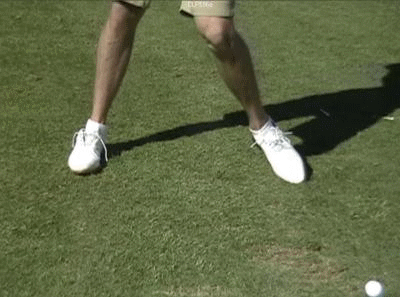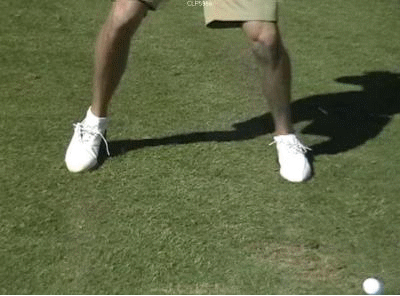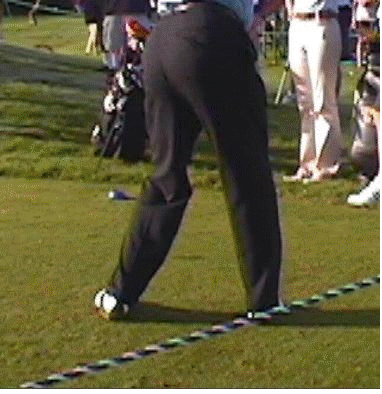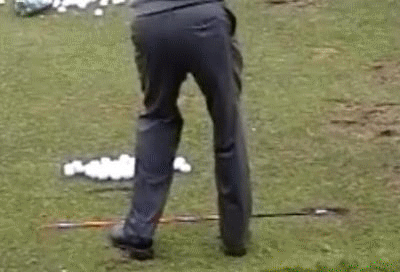Sadlowski Footwork For Longer Drives
- by Kelvin Miyahira
Since I’m old, I can remember pictures of Jack Nicklaus in the mid 1970’s hitting the ball with a perfectly flat left foot at impact (he rolled his feet over post-impact). Then we saw Greg Norman with his feet moving all over the place. I took that as an abnormality and dismissed it. Nick Faldo came along and had a nice, quiet foot at impact (perhaps indication of the WUT swing?). Then Tiger comes along and we saw feet moving again. So it got me to thinking, what’s going on?
Are we supposed to have quiet, stable looking feet at impact, or not?
From the aspect of physics, “more planted” could mean greater ground reaction force. But on the other hand, perhaps the ground force could have been generated before impact. Hmmmmm.
My belief is that the feet and legs should be dynamic and moving instead of quiet but there is a method to the madness. Long Drive Champion Jamie Sadlowski surely has the right type of movement in his feet. He’s swinging at close to 155 miles per hour and is producing more force (and higher RFD) than someone swinging at 125 mph. Tiger has similar moves though not nearly as forceful since accuracy is very important on the tour.
Granted we may be talking apples and oranges here because Long Drive Competitions are not PGA tour events where accuracy and short game are important but there are things we can learn from both of these champions so that we can ultimately improve our game.
Let’s start by taking a deeper look into the footwork of Jamie.
Foot Plant
As discussed in previous articles, the closed hip slide occurs during transition. Jamie and Tiger both have a closed left heel slide that coincides with this hip slide. As you can imagine, this is all part of the symphony (or rock concert) of their swings.

Notice the left heel has slid forward towards the target. This is more an indication of the lower body shift forward. Many amateurs make the opposite move by sliding the left heel back away from the target during transition or at the start of the downswing. This shows the spinout move typical of a slicer.
If there is one killer move, that would be it. If the left heel slides back during transition, it will prematurely open the hips without any weight transfer or slide. In turn this will force the shoulders to open too early as well. But the main problem with this move would be that it would effectively ruin any chance to fire the body again before impact. The arms would be the only body part capable of moving.
Fire!
After the foot plant is complete, there is little time to waste. The legs and hips must fire immediately thereafter. The left leg begins to jump up (Multiple Firing Theory swing) and rotate the left hip back (away from the target) and up. The resulting foot movement will be quite different than what you would imagine a correct move to be. But this is not a beauty contest or a ballroom dance. It’s all about speed and power in a golf swing.


Okay, so in contrast, here’s epitome of gracefulness and beauty in a golf swing: Ernie Els.

His feet have the same movements at Jamie albeit with just a little less speed and power. The same could be said for Tiger but then again Jamie does hit it about 100 yards farther than the PGA tour guys.
These are Ernie’s foot movements. Can you see any similarities to Jamie’s?
Whip ‘Um Theory Footwork
Former #2 player in the world Phil Mickelson has been blindsided by the WUT theory swing. Having trust and faith in one’s instructor can be good but sometimes you have to wonder what could have been…………..
He’s probably one of the most talented guys on tour but he’s got very little dynamics in his lower body. The lack of lower body dynamics limits the length of his drives and keeps him from going for more on those occasions he needs it. This was so apparent in the FBR Open playoff earlier this year against JB Holmes. Phil decided to lay up short of a water hazard 300 yards away while JB ripped his driver and carried the hazard with a 360-yard drive. JB made birdie with a SW to the green and won the tournament.
The problem plaguing Phil is that his hands and upper body have been trained to be the primary power producers. Therefore, when swinging faster or harder than normal, it is unknown whether or not his lower body will fire fast. His athletic instincts would be to fire his lower body hard and fast but years of detraining causes him to slow it down. It’s a roll of the dice under that kind of pressure.
This obviously will cause timing problems for his hands and lead to some of the direction problems he’s had under pressure i.e. 2006 US Open 18th hole at Winged Foot CC where he hit deep into the trees and almost went OB on his way to a double bogey.
Thus, in this situation, he chooses to stay in control and lay up with the three-wood. This method wins some of the time but it seems to me that the writing is on the wall. Tiger, Sergio, JB, Padraig, Angel, Camillo, AK and the rest of the bombers will take over the tour. Let’s hope Butch can help him get on track.
But I digress. Let’s get back to the analysis to see how this different type of swing shows up in a different pattern of footwork and leg movements.

Notice these little things.
If you become so anchored or planted to the ground with your footwork, you’ll swing like a palm tree in the wind -- the top moves but the closer it gets toward the bottom, not much moves. More importantly, the largest, most powerful muscles are in the lower body. So why not use them?
Contrast that with Jamie’s footwork. It’s like the whole palm tree being twisted and spun out of the ground by a whirling tornado. This is how your feet MUST work in order to facilitate high speed, high-energy body dynamics.
There is more to be explored with the MFT swing. Next month, we will investigate the new discovery of what I’m calling the “Chi line.” This is really how the long hitters use physics and Eastern philosophy energy centers (whether or not they realize it) to maximize their trunk rotational speed at impact.
Are we supposed to have quiet, stable looking feet at impact, or not?
From the aspect of physics, “more planted” could mean greater ground reaction force. But on the other hand, perhaps the ground force could have been generated before impact. Hmmmmm.
My belief is that the feet and legs should be dynamic and moving instead of quiet but there is a method to the madness. Long Drive Champion Jamie Sadlowski surely has the right type of movement in his feet. He’s swinging at close to 155 miles per hour and is producing more force (and higher RFD) than someone swinging at 125 mph. Tiger has similar moves though not nearly as forceful since accuracy is very important on the tour.
Granted we may be talking apples and oranges here because Long Drive Competitions are not PGA tour events where accuracy and short game are important but there are things we can learn from both of these champions so that we can ultimately improve our game.
Let’s start by taking a deeper look into the footwork of Jamie.
Foot Plant
As discussed in previous articles, the closed hip slide occurs during transition. Jamie and Tiger both have a closed left heel slide that coincides with this hip slide. As you can imagine, this is all part of the symphony (or rock concert) of their swings.

Notice the left heel has slid forward towards the target. This is more an indication of the lower body shift forward. Many amateurs make the opposite move by sliding the left heel back away from the target during transition or at the start of the downswing. This shows the spinout move typical of a slicer.
If there is one killer move, that would be it. If the left heel slides back during transition, it will prematurely open the hips without any weight transfer or slide. In turn this will force the shoulders to open too early as well. But the main problem with this move would be that it would effectively ruin any chance to fire the body again before impact. The arms would be the only body part capable of moving.
Fire!
After the foot plant is complete, there is little time to waste. The legs and hips must fire immediately thereafter. The left leg begins to jump up (Multiple Firing Theory swing) and rotate the left hip back (away from the target) and up. The resulting foot movement will be quite different than what you would imagine a correct move to be. But this is not a beauty contest or a ballroom dance. It’s all about speed and power in a golf swing.

- Notice how his left foot is floating on the outside edge of the shoe. This is the result of “un-weighting” his left leg in order to spin faster.
- His left heel has spun back towards his right foot.
- Toes have spun to point more towards the target.

- Inverse movement of right and left foot -- as left foot drops, right foot lifts.
- Right leg and foot haven’t fired yet; they are just getting into position very quickly
- When the real firing starts, a drastic change appears in right calf muscles
Okay, so in contrast, here’s epitome of gracefulness and beauty in a golf swing: Ernie Els.

His feet have the same movements at Jamie albeit with just a little less speed and power. The same could be said for Tiger but then again Jamie does hit it about 100 yards farther than the PGA tour guys.
These are Ernie’s foot movements. Can you see any similarities to Jamie’s?
- Heel slide towards target at foot plant.
- Left foot is floating on the outside edge of the shoe. This happens just a little later than Jamie’s though.
- His left heel has spun back towards his right foot.
- Toes have spun to point more towards the target.
Whip ‘Um Theory Footwork
Former #2 player in the world Phil Mickelson has been blindsided by the WUT theory swing. Having trust and faith in one’s instructor can be good but sometimes you have to wonder what could have been…………..
He’s probably one of the most talented guys on tour but he’s got very little dynamics in his lower body. The lack of lower body dynamics limits the length of his drives and keeps him from going for more on those occasions he needs it. This was so apparent in the FBR Open playoff earlier this year against JB Holmes. Phil decided to lay up short of a water hazard 300 yards away while JB ripped his driver and carried the hazard with a 360-yard drive. JB made birdie with a SW to the green and won the tournament.
The problem plaguing Phil is that his hands and upper body have been trained to be the primary power producers. Therefore, when swinging faster or harder than normal, it is unknown whether or not his lower body will fire fast. His athletic instincts would be to fire his lower body hard and fast but years of detraining causes him to slow it down. It’s a roll of the dice under that kind of pressure.
This obviously will cause timing problems for his hands and lead to some of the direction problems he’s had under pressure i.e. 2006 US Open 18th hole at Winged Foot CC where he hit deep into the trees and almost went OB on his way to a double bogey.
Thus, in this situation, he chooses to stay in control and lay up with the three-wood. This method wins some of the time but it seems to me that the writing is on the wall. Tiger, Sergio, JB, Padraig, Angel, Camillo, AK and the rest of the bombers will take over the tour. Let’s hope Butch can help him get on track.
But I digress. Let’s get back to the analysis to see how this different type of swing shows up in a different pattern of footwork and leg movements.

Notice these little things.
- No transition
- No fall in
- Late squat position
- Flat-footed at impact (both feet)
- Late back knee kick in (are legs just tagging along for the ride?)
- Extra slide forward through impact with the lead knee (no jump)
- No “glute” firing
If you become so anchored or planted to the ground with your footwork, you’ll swing like a palm tree in the wind -- the top moves but the closer it gets toward the bottom, not much moves. More importantly, the largest, most powerful muscles are in the lower body. So why not use them?
Contrast that with Jamie’s footwork. It’s like the whole palm tree being twisted and spun out of the ground by a whirling tornado. This is how your feet MUST work in order to facilitate high speed, high-energy body dynamics.
There is more to be explored with the MFT swing. Next month, we will investigate the new discovery of what I’m calling the “Chi line.” This is really how the long hitters use physics and Eastern philosophy energy centers (whether or not they realize it) to maximize their trunk rotational speed at impact.

